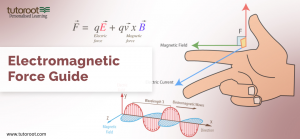How Electromagnetic Force Drives Innovations in Technology?
Electromagnetism = Electricity + Magnetism.
For a long time, electricity and magnetism were regarded to be independent forces. It wasn’t until the nineteenth century that they were eventually recognized as interconnected occurrences. However, in practice, electric and magnetic forces behave quite differently and are represented by distinct equations. Electric current, whether at rest or in motion, generates electric forces. Magnetic forces, on the other hand, are only created by moving charges and operate only on moving charges.
What is Electromagnetic Force?
Electromagnetic force is a physical contact that takes place between electrically charged particles. It is the combination of all magnetic and electrical forces that be between charged particles. The electromagnetic force may be both appealing and repellent. There are two types of electromagnetic forces; Electrostatic forces and magnetic forces.

People and scientists used to believe that electricity and magnetism were two separate issues before the creation of electromagnetism. After James Clerk Maxwell released A Treatise on Electricity and Magnetism in 1873, people’s perspectives shifted. According to the article, the interaction of positive and negative charges is mediated by a single force. This discovery created the groundwork for electromagnetism. Later, several scientists, like Michael Faraday, Oliver Heaviside, and Heinrich Hertz, contributed to electromagnetic with their concepts.
The Electromagnetic force formula is F = q v × B. Where F is the magnetic force, v is the velocity of the charged particles, and B is the magnetic field. The q represents the electric charge of the particle.
What is Electromagnetism?
Electromagnetism is the method of creating a magnetic field by passing electricity through a conductor. When a conductor is electrically charged, magnetic lines are produced. For example, if current or positive charges, flow along a wire, the magnetic field along the wire is produced, and the direction of magnetic lines and force may be established using the Right-hand Rule. For a complete explanation, please see the graphic.
Fleming’s Left-Hand and Right-Hand Rule
Right-Hand Rule
According to Fleming’s Right Hand Rule, if we organize our right-hand thumb, forefinger, and middle finger perpendicular to each other, the thumb points toward the direction of the conductor’s motion relative to the magnetic field, the forefinger points toward the direction of the magnetic field, and the middle finger points towards the direction of the induced current.
Left Hand Rule
According to Fleming’s Left Hand Rule, if we arrange our left-hand thumb, forefinger, and middle finger perpendicular to each other, the thumb points in the direction of the force experienced by the conductor, the forefinger points in the direction of the magnetic field, and the middle finger points in the direction of the electric current.
What is Electromagnetic Induction?
We’ve seen what occurs when an electrically charged conductor is. Let’s explore what happens if we put a conductor between the magnetic field and the magnet.
When a conductor passes through a magnetic field, it creates voltage or electricity. This is known as Electromagnetic Induction. The voltages produced are determined by the speed of the conductor that moves through the electric field. The stronger the induced electricity or voltage, the faster the conductor.
Faraday’s Law
According to Faraday’s Law, the flux linkage varies with the relative motion of the magnetic field and the conductor, and this change in flux generates a voltage across the coil.
Example of explanation
DC The generator operates based on Faraday’s Law of Electromagnetic Induction. It is a method for converting mechanical energy to electrical energy.
Electromagnetic Wave Properties
Electromagnetic waves have the following properties:
- Electric and magnetic waves oscillate at right angles to one another to generate electromagnetic waves.
- They have interference and diffraction characteristics.
- In a vacuum, they travel at a speed of 3 X 108m/s.
- Transverse waves.
- The connection between an electromagnetic wave’s wavelength (λ) and frequency (c) is c = v λ.
Electromagnetism Applications
Among the many uses of electromagnetism are:
- Many home appliances in domestic applications rely on electromagnetism as a key operating mechanism.
- Maglev trains operate on the electromagnetic principle.
- In a communication system, electromagnetic radiation is utilized to transmit data from the source to the receiver.
- Electromagnetism is employed at some point in the manufacturing process in sectors ranging from small devices to huge power equipment.
Electromagnetism Examples
The following are some examples of electromagnetism-based equipment or situations:
- Kitchen Microwave
- Digital cameras
- Cell phones
- Thermometers
- Optical instruments
- Magnets
- Compasses
- Irons
- Ultrasound equipment
- Oscilloscopes
- Mass spectrometers
- Modems
- Tomographs
- Mammographs
Final Notes
Join Tutoroot’s personalized classes to get help understanding the Electromagnetic Force more precisely in person. Our online home tutor will be more than happy to assist you.
FAQ’s
Define Electromagnetism.
Electromagnetism – the study of the electromagnetic force between electrically charged particles.
What is Electromagnetic Force Formula?
The Electromagnetic force formula is F = q v × B.
